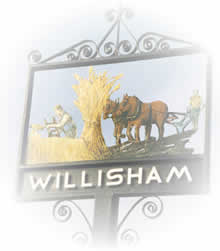
Offton and Willisham
Parish Council

Parish Council
The name WILLISHAM is derived from Wiglaf Meadow or Enclosure. The name Wiglaf occurs in Beowulf.
The suffix HAM means:
A home or village or a village community
An "enclosure" or "a place fenced in"
Previous names for Willisham include:
Wylavesham
Willavesham
Wylewesham
Boundary changes in 1884 meant part of the “village” (detached parts of Nettlestead, Offton and Somersham) were moved for administration purposes. Gained parts of Offton
Inhabited Houses were 10 (1674); 20 (1801); 44 (1851); 46 (1871); 37 (1901); 35 (1951); 71 (1981).
Population was: 22 (1086); 19 taxpayers (1327); 13 taxpayers (1524); 50 adults (1603); 16 households (1674); 154 inhabitants (1801); 224 inhabitants (1831); 213 inhabitants (1851); 204 inhabitants (1871); 141 inhabitants (1901); 119 inhabitants (1931); 120 inhabitants (1951); 254 inhabitants (1971) 215 inhabitants (1981).
Between 1600 and 1649 occupations were 4 yeomen, 1 weaver and 3 husbandmen
In 1831 occupations were 40 in agriculture, 5 in retail trade and 6 in domestic service.
In 1912 occupations were 3 farmers, shopkeeper, beer retailer and thatcher.
Children attended school in Offton between 1891 and 1912
A beerhouse (the SHOULDER OF MUTTON) is recorded in 1844 and a beer retailer operated between 1891 and 1912.
Willisham Hall was recorded as having 11 hearths in 1674. It was destroyed by fire in 1934 and the parish registers are believed to be destroyed in that fire.
The adult population of Offton now stands at about 293 with 200 in Willisham.
Further information about local history can be obtained from the Public Records Office in Ipswich.
Click here to read about St Mary's Church - Willisham